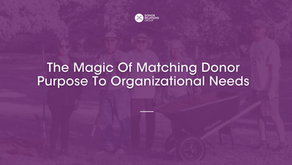Engagement That Lasts: How to Cultivate Lifelong Donor Connections
- Lynne Wester

- Sep 16
- 3 min read

When we take a closer look at thriving advancement shops, one thing stands out: they all view donor relations as a long-term, behavior-based strategy rather than a series of one-time tasks. It’s not enough to simply thank donors for their latest gift. We need to build lasting connections—creating experiences and touchpoints that keep donors engaged for years, if not a lifetime.
Why Behavior-Based Donor Relations Matters
Too often, donor relations rely on recognition based on gift amounts. However, when we focus on donor behavior, such as their first gift, recurring donations, upgrading their support, or engaging through multiple channels, we meet donors where they are. This approach makes stewardship more personal, relevant, and effective. After all, donors want to feel seen not just for what they give, but for how they engage.
Lynne Wester, DRG’s principal and founder, captures this beautifully:
“We need to rethink what we consider ‘good donors’ and change our behavior to rectify some of the wrongs and make it a more inclusive experience for anyone who decides to be generous. Somewhere in your database is the next million-dollar donor; she is waiting for you to notice her.”
Behavior-based strategies also give us the opportunity to scale. Not every donor will receive individualized attention from gift officers, but every donor deserves thoughtful stewardship. Most of the time, we tend to focus on the top and the bottom of the giving funnel. Often, this translates into focus, interactions, and plans for major/principal and lower-level donors. By focusing on behavior, we create experiences that deepen loyalty across the entire donor base, not just the top tier.
Partnering with Gift Officers
The most impactful donor journeys happen when donor relations, annual giving teams, and gift officers work together instead of separately. Gift officers offer valuable insights into donor motivations and objectives. Donor relations teams maintain consistency and follow-up across portfolios. Together, they deliver a smooth donor experience, from the initial gift to transformational philanthropy.
Don’t Forget Annual Giving and Midlevel Donors
One area we chronically underinvest in is leadership annual giving (LAG) and midlevel donors. They’re the pipeline to major gifts but often fall into a stewardship gap: too large a group for personalized attention, yet too impactful to be treated like general annual donors.
Behavior-based stewardship can foster truly meaningful engagement with this group. Consider targeted impact reports, smaller events, peer connections, and recognition that emphasize their ongoing loyalty. These donors show us, through their actions, that they care deeply. We can’t afford to neglect them.
Building Relationships That Last
Lifelong engagement isn’t accidental; it’s the result of intentional strategy. When donor relations teams concentrate on behaviors, work effectively with gift officers, and give LAG and midlevel donors the attention they deserve, we build relationships that honor today’s gifts and motivate tomorrow’s.
As Lynne often reminds us:
“If you don’t have an attitude of gratitude, the work you are doing isn’t as meaningful. People choose to give to us, and we need to be grateful for those who do give.”
“The number one measure of success is donor retention.”
The real question for advancement leaders:
Are we structuring our donor relations to honor every donor journey, or only showing up for the top of the pyramid?
Now is the perfect moment to review your donor engagement plan. If you’re ready to make the shift, here’s where to begin:
1. Audit Your Current Engagement Touchpoints
Look at your recent donor communications and events.
Are they tied to gift amounts or to donor behaviors like first-time gifts, recurring giving, or volunteering?
Choose one behavior you can begin recognizing consistently—regardless of giving level.
2. Build a Donor Behavior Matrix
Create a timeline of touchpoints (email, call, handwritten note, small surprise).
Fill in ideas that match the behavior with relevant and scalable stewardship touches.
3. Use the “DX Lens” (Donor Experience)
Ask yourself, "Would I feel seen, known, and valued if I received this?"
If the answer is no, revise the experience.
4. Partner with Gift Officers Intentionally
Schedule quarterly strategy huddles between donor relations and frontline fundraisers.
Use the time to create intentional interactions for your lower-level, annual, and mid-level donors.
Once you've done this well for one behavior, select another and start the list again.
The next generation of lasting donors is already in your database—let’s make sure they feel valued enough to stay with you long-term.
Written by Jenny Jones





